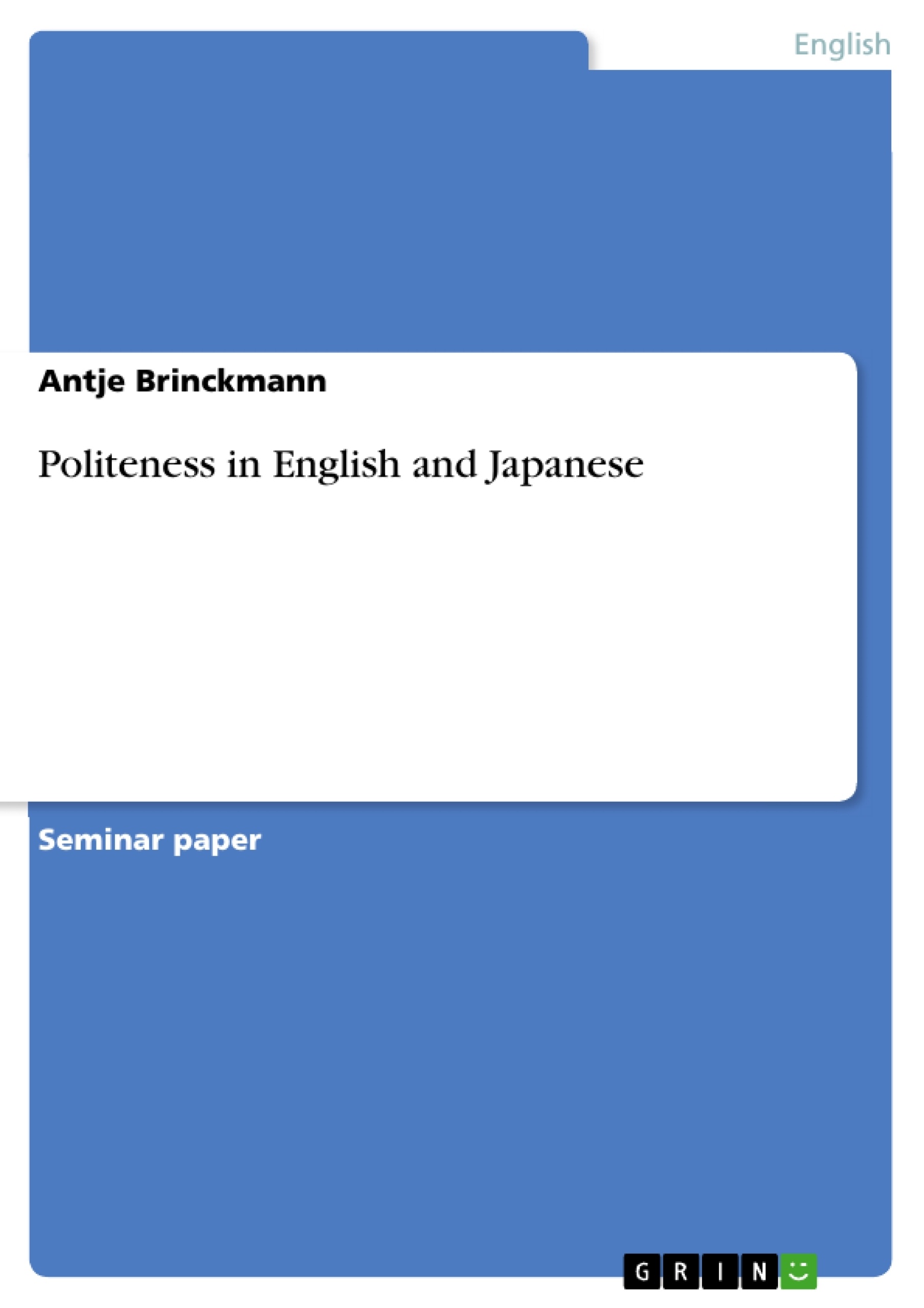Politeness is the flower of humanity”, (Joseph Joubert , 1754 – 1824, French moralist). “Politeness is to human nature what warmth is to wax”, (Arthur Schopenhauer, 1788- 1860, German philosopher).
Politeness and tact play an important role in dealing with other people. The term calls a behaviour that shall demonstrate respect for the vis – à – vis. In order to avoid embarrassing situations or abashing someone polite behaviour has to be used. In the following paper, I will deal with the topic “Politeness in English and Japanese.” As a basic concept I will use two essays: “Politeness and conversational universalsobservation from Japanese” by Yoshiko Matsumoto (1989) and “Keigo – Höflichkeit und soziale Bedeutung im Japanischen” by Florian Coulmas (1987). On the basis of these two papers I want to show what politeness is like in Japanese and English and whether the principles of conversation generated by Grice (1975) and Brown and Levinson’s theory of politeness (1978, 1987) are universal as they are claimed to be. In order to analyse this assertion I will take a closer look on the Japanese language.
At first I will give basic information to understand what the respective theory is about. I will first give an overview of Grice’s theory and will then focus on Brown and Levinson’s theory of politeness and explain their notion. The next point will comprise the transformation of the theories’ properties on the Japanese language to confute or verify their alleged universality. I will use Matsumoto’s and Coulmas’ essays to indicate the construction of the Japanese language and will demonstrate this with many examples. Subsequently I will illustrate whether Brown and Levinson’s theory is also appropriate for the Japanese language system. Section five will give a summary of the topic and present the result of the analysis.
Inhaltsverzeichnis (Table of Contents)
- Introduction
- Definition Politeness
- Basics
- Grice's theory of conversation (1975)
- Basic Idea
- Grice "Maxims of Conversation"
- Conversational vs. Conventional implicatures
- Brown and Levinson's theory of politeness (1978, 1987)
- Negative and Positive Face
- Face Threatening - Acts (FTAs)
- Grice's theory of conversation (1975)
- Grice's theory of conversation and Brown and Levinson's theory of politeness applied on the Japanese language including the comparison between English and Japanese politeness
- Conclusion
Zielsetzung und Themenschwerpunkte (Objectives and Key Themes)
The paper aims to explore the concept of politeness in English and Japanese, utilizing the theories of Grice and Brown and Levinson. By analyzing the Japanese language, it investigates the universality of these theories and their applicability in a different cultural context.
- Definition and function of politeness
- Grice's theory of conversation and its core principles
- Brown and Levinson's theory of politeness and its key concepts
- The application of these theories to the Japanese language
- Comparison of politeness in English and Japanese
Zusammenfassung der Kapitel (Chapter Summaries)
- Introduction: This chapter introduces the topic of politeness and its significance in communication. It outlines the scope of the paper, including the focus on English and Japanese languages, and mentions the key theoretical frameworks used: Grice's theory of conversation and Brown and Levinson's theory of politeness. The chapter also briefly describes the organization of the paper.
- Definition Politeness: This chapter defines politeness as a behavior that demonstrates respect for the interlocutor, crucial for avoiding uncomfortable situations. It highlights the role of politeness in facilitating smooth communication and interaction.
- Basics: This chapter introduces the basics of Grice's theory of conversation, focusing on its cooperative principle and the four "Maxims of Conversation". It also discusses the different types of implicatures, including conventional and conversational implicatures. The chapter concludes by introducing Brown and Levinson's theory of politeness, explaining their concept of "face" and "face-threatening acts."
- Grice's theory of conversation and Brown and Levinson's theory of politeness applied on the Japanese language including the comparison between English and Japanese politeness: This chapter delves into the application of Grice's and Brown and Levinson's theories to the Japanese language, examining the specific linguistic features and cultural norms related to politeness. It explores whether these theories are universally applicable and how they differ in the context of the Japanese language.
Schlüsselwörter (Keywords)
The core concepts of the paper revolve around politeness, communication, language, culture, conversation, Grice's theory, Brown and Levinson's theory, Japanese language, English language, cultural differences, conversational implicatures, face, face-threatening acts, and universality.
- Quote paper
- Antje Brinckmann (Author), 2005, Politeness in English and Japanese, Munich, GRIN Verlag, https://www.grin.com/document/65840



